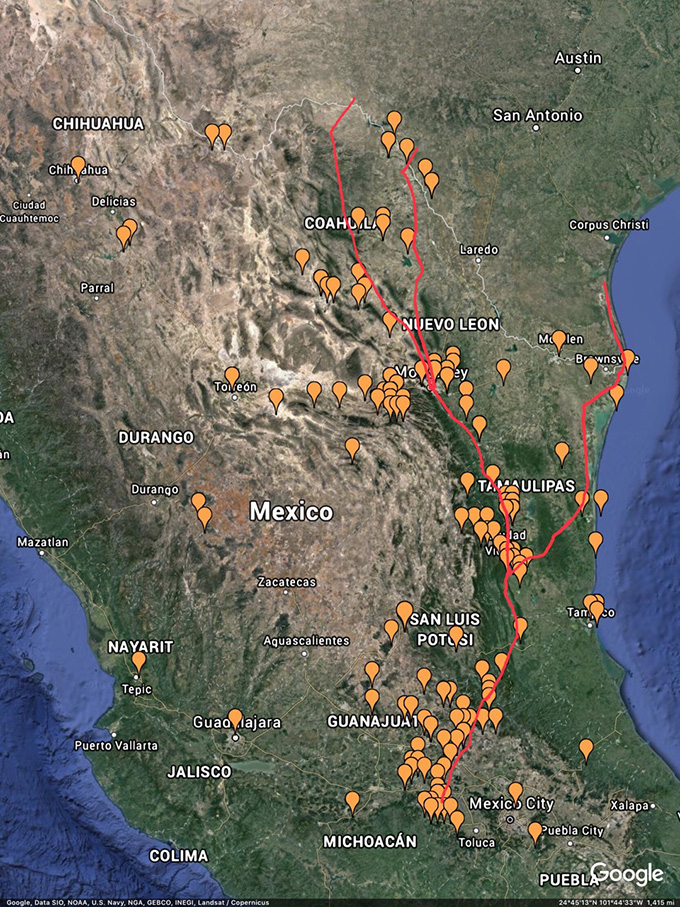Monarch Population Status
Friday, March 15th, 2019 at 8:23 am by Chip TaylorFiled under Monarch Population Status | Comments Off on Monarch Population Status
Will the population increase again this year? Last season the population increased from 2.48 hectares to 6.05 (see the January 30th Monarch Population Status announcement). If the monarchs wintered well, that is with a normal rate of mortality and morbidity, that should result in a relatively large (compared to recent years) returning population with the potential to yield another large migration and overwintering population. Right? Maybe and maybe not.
To forecast what might happen we have to know what happens during March and April in the South Region and then what happens in May as the first generation moves northward. Timing and numbers are critical to understanding the prospects that the population will grow or decline.
Ok, so what is happening now? There is good news, some questions and perhaps more good news.
The first bit of good news is the sighting of 27 monarchs in Texas in the first 10 days of March. That’s the highest number for this period since Journey North started keeping records in 2000. Some of these records indicate that monarchs are well into Texas, having reached Austin and beyond. The question is how many monarchs are already in Texas and how many are still moving northward through Mexico? It is probable that most of the monarchs are still en route and we know that substantial numbers still remain at some of the colonies.
I raise this issue because it looks like the two monarch pathways through Mexico (see figure below) are going to be shut down by cold weather from 15-22 March. This shutdown could mean that once the weather warms in northeast Mexico, monarchs could flood into Texas after the 22nd. The effect would be late arrivals for the majority of monarchs coming out of Mexico and that would not be a good thing. The peak arrival in Texas is usually from 21-25 March and often from 26-30 March. Later arrivals are often associated with lower population numbers.
The good news comes in twos. First, the weather for monarchs that have already reached Texas will be favorable for feeding, mating, egg laying, larval growth rate and movement to the northeast. Secondly, the long range forecast, if accurate, indicates that most of the returning monarchs will lay the majority of their eggs in Texas, and the southern half of Oklahoma. Restricting egg production to Texas and Oklahoma is a good thing since it will minimize the average age to first reproduction of the progeny of the returning monarchs. The population has increased each year egg distribution has been limited to the lower portion of the South Region.
Returning monarchs that have survived to mid-April in Oklahoma will be able to continue moving northeast once the daytime highs reach the lower 70s. A few of these may reach Kansas but the number reaching northeast Kansas, where I am, will be few, if any, unless the forecast is wrong and the numbers returning to Texas are higher than in recent years.
The bottom line — I’m cautiously optimistic that the population will get off to a good start this breeding season. I’m keeping my fingers crossed that my key assumptions – good returning numbers, restricted egg laying, and favorable weather conditions – will be validated in time.
The figure below represents the two main pathways by which returning monarchs enter Texas from Mexico. The distance along the coastal pathway to the milkweed-rich areas of Texas is about 600 miles. The montane or interior pathway is about 800 miles. The latter appears to be the favored route since the temperatures along the coastal pathway are often too high for migratory flight. The location markers represent all spring first sightings reported to Journey North for Mexico. Figure created by Janis Lentz.

Addendum
The flow of overwintered monarchs returning to Texas continued after the 10th and through the 14th 75 first sightings had been reported to Journey North. However, since Journey North hasn’t picked up the sightings posted to our email discussion list (Dplex-L) and perhaps some posted to Facebook, this number is an underestimate. Further, there have been at least four reports of sightings of 20 or more monarchs seen moving N/NE at different locations. These sightings of multiple monarchs on the move in short time periods are unprecedented. A review of the Journey North first sightings from 2000 to present shows that there was only one other year, 2012, with a similar number of sightings through the 14th – 87. As you may recall, March of 2012 was hottest ever recorded in the U.S. The population declined that year from 2.89 to 1.19 hectares. Now, as in 2012, substantial numbers of monarchs have advanced into areas ahead of the appearance of milkweeds. The Journey North Map of first sightings for 2012 indicates that the returning migrants moved too far north too soon, a factor that probably contributed to the lower numbers the following winter. That scenario seems unlikely to develop this year. According to the long-range forecasts, the temperatures are likely to limit most of the northern movement in the Midwest to Texas and Oklahoma. I’ve said it before “Every year is different yet every year is the same”. The trick is to distinguish what is the same through the multi-decade record from what is different each year and among years. – CT


Sorry, comments for this entry are closed at this time.